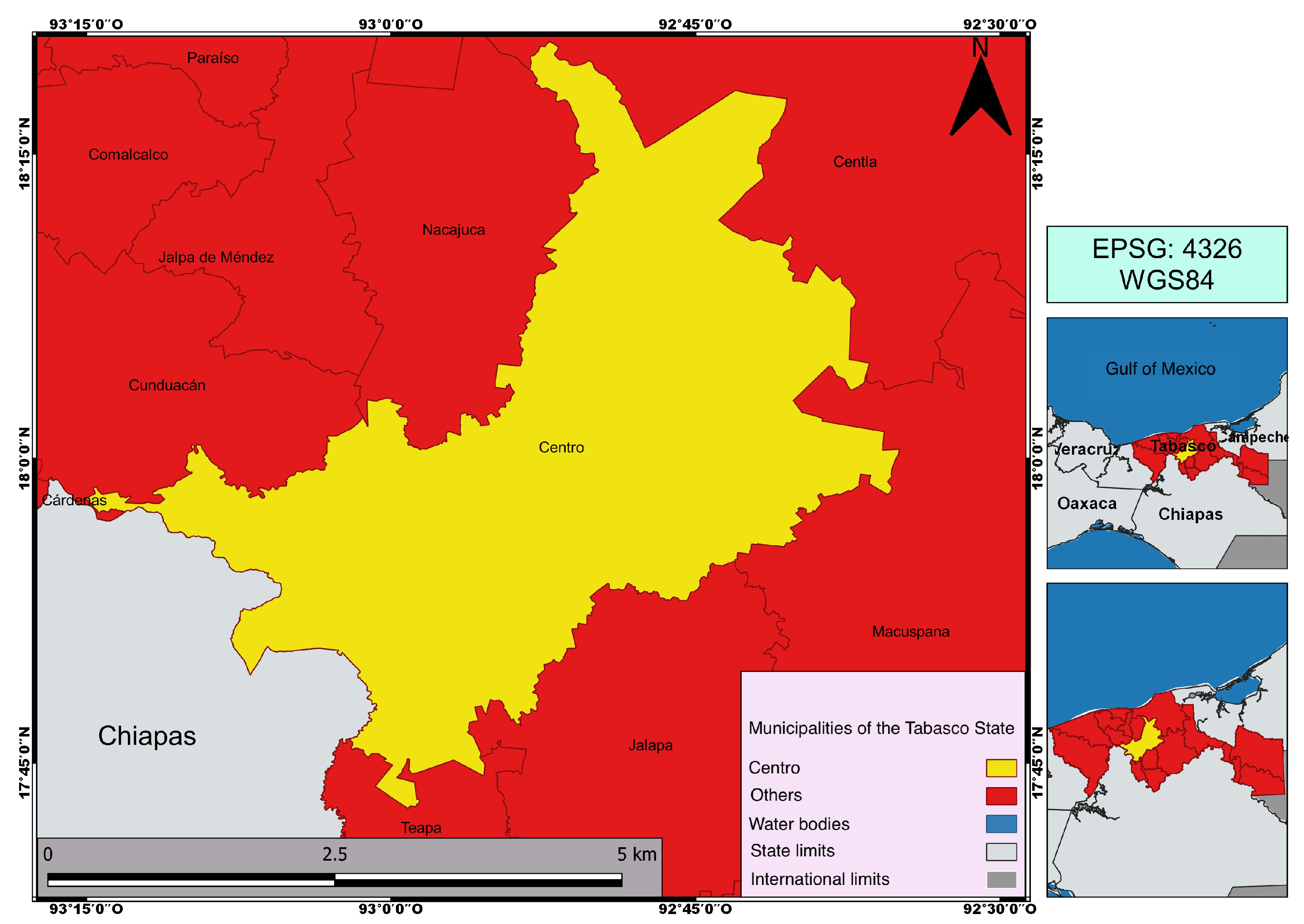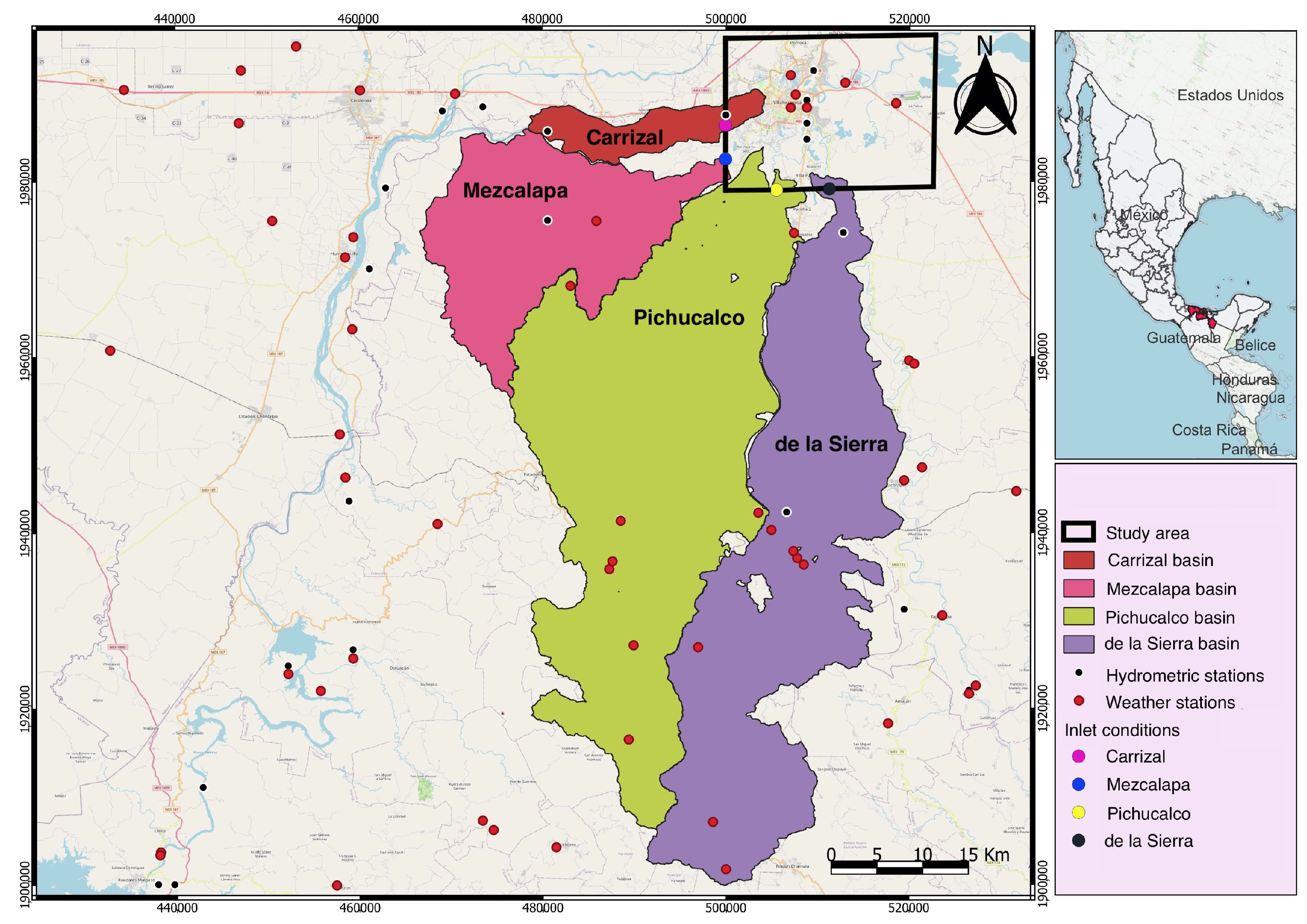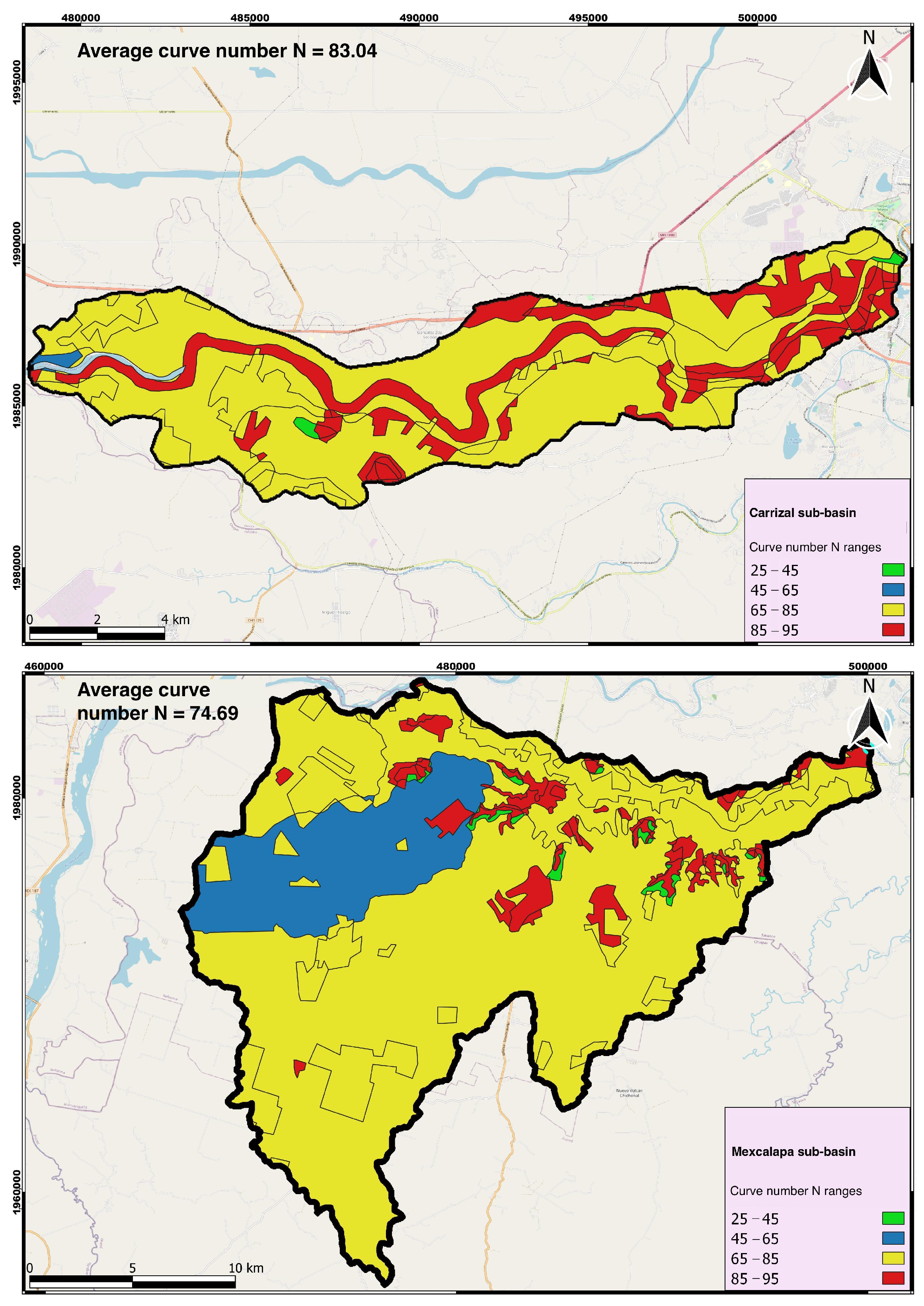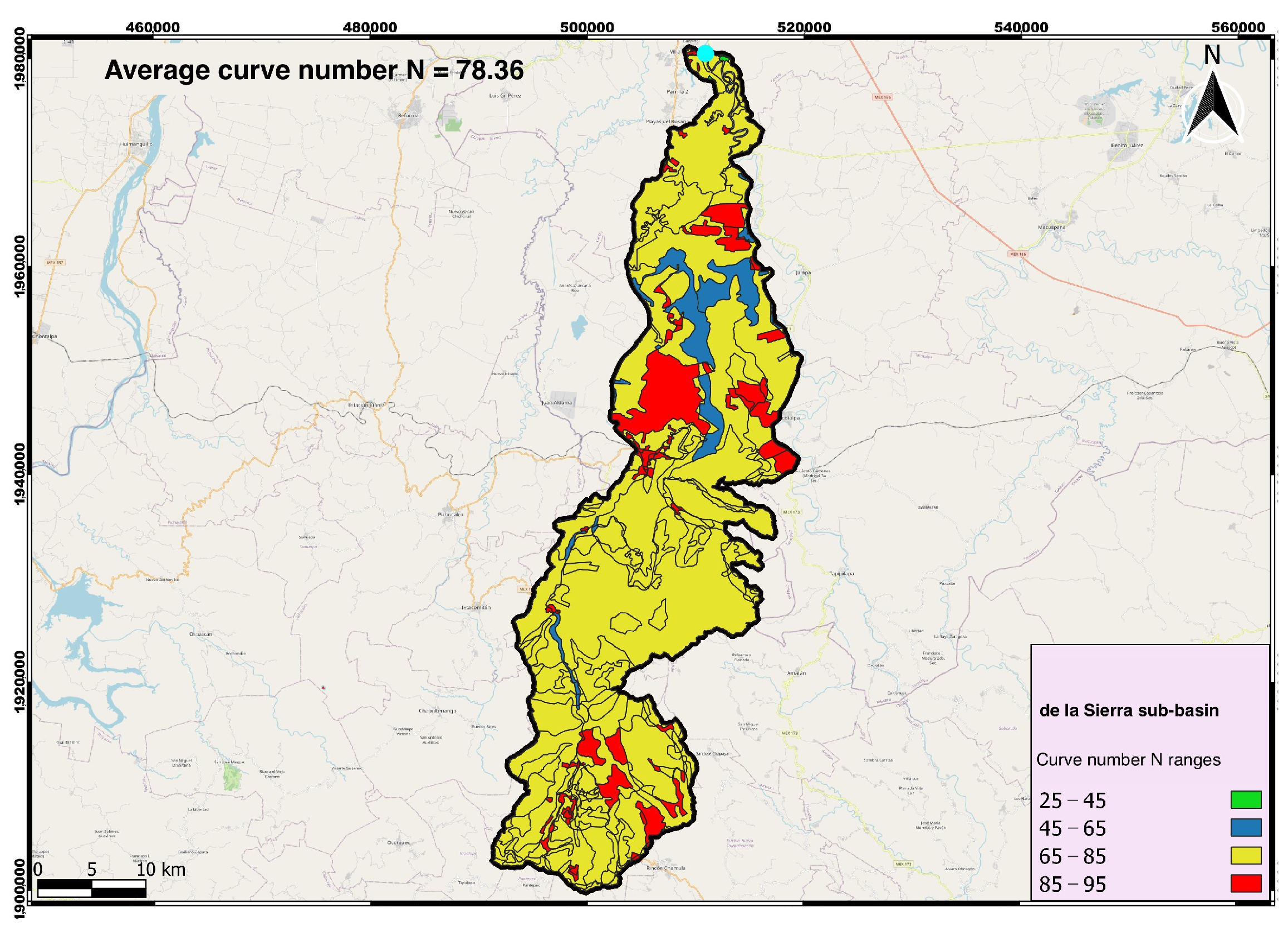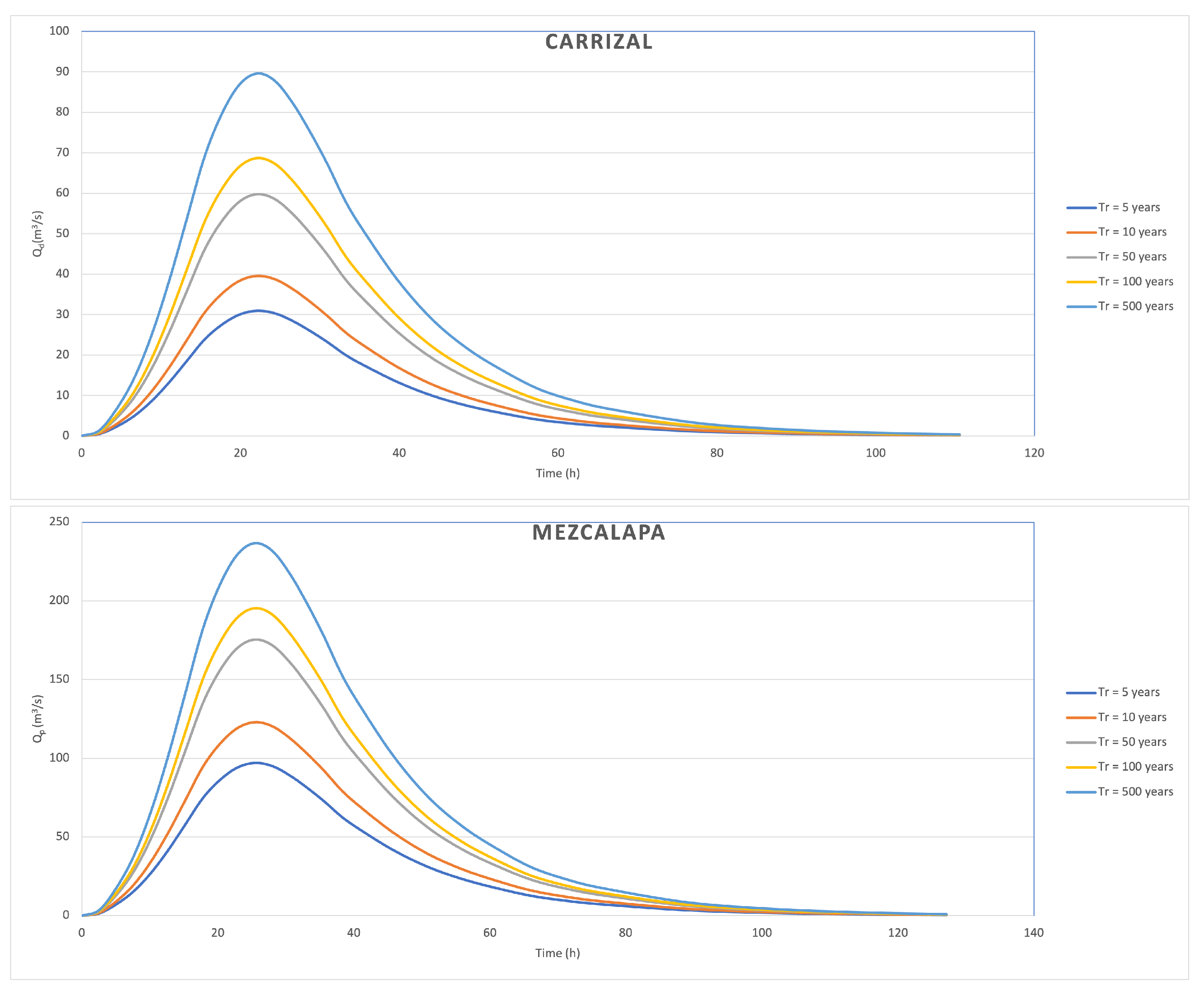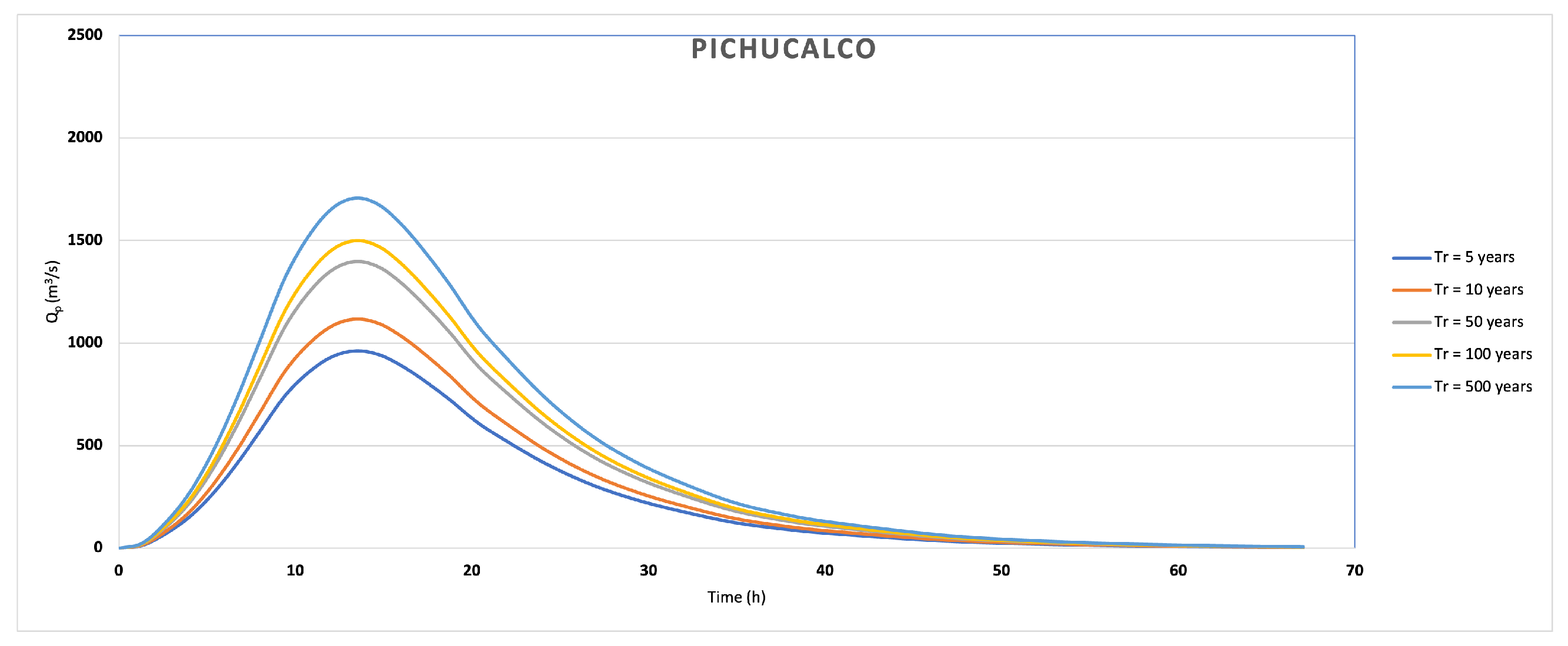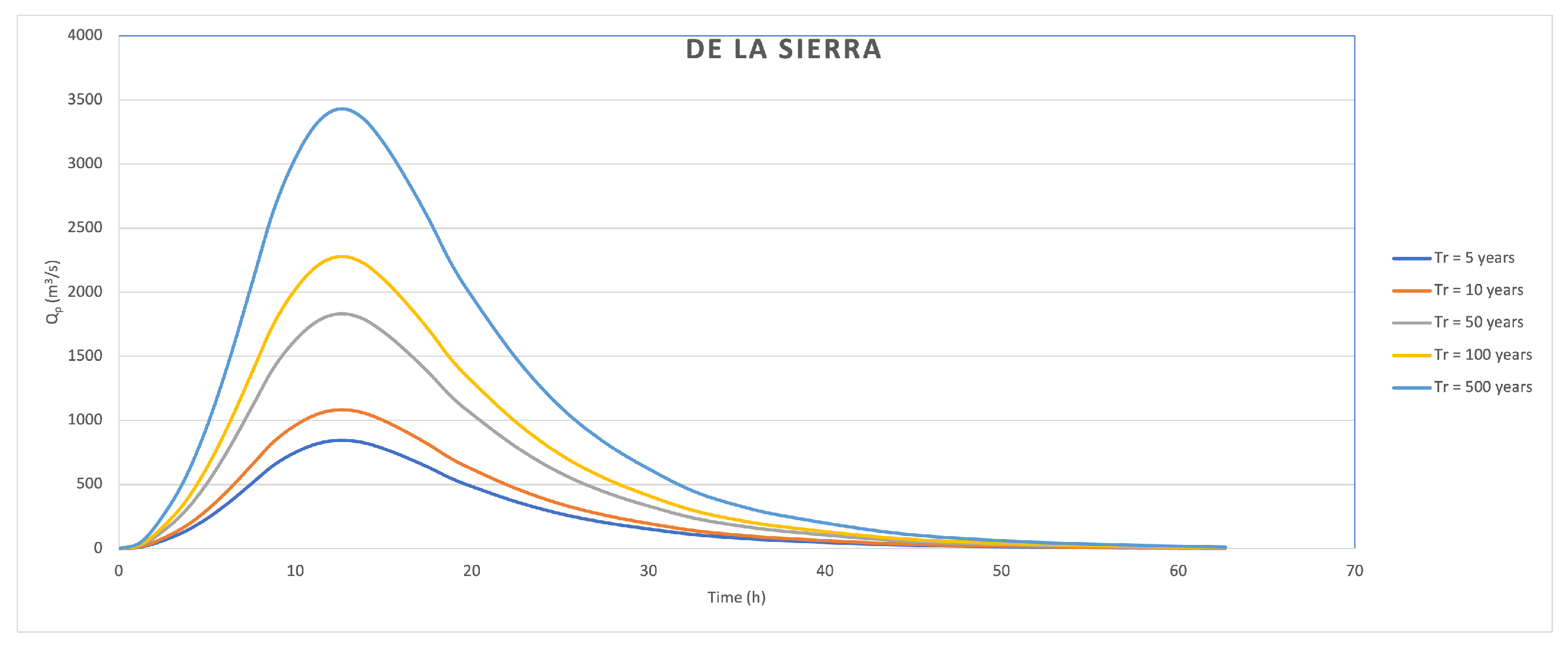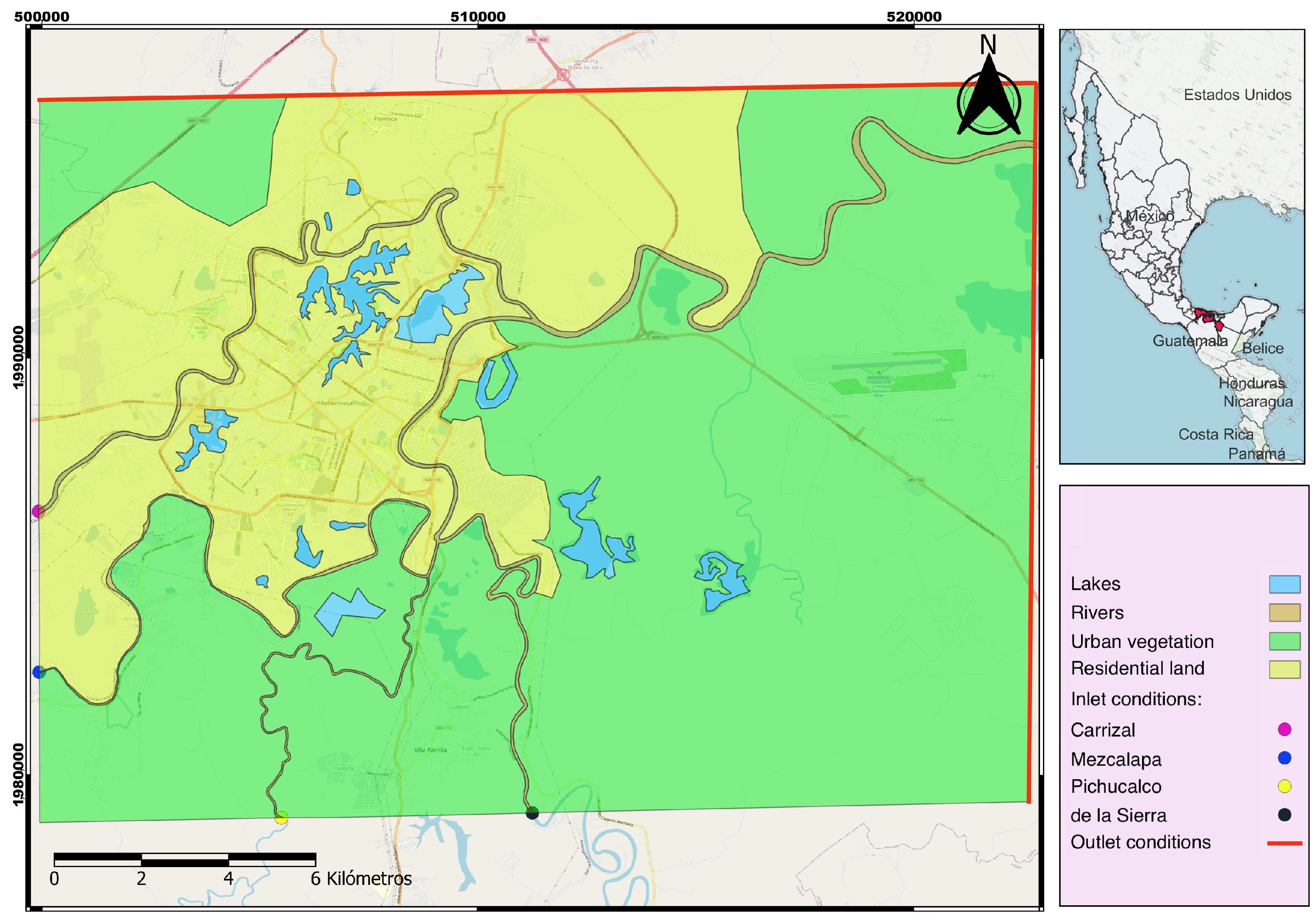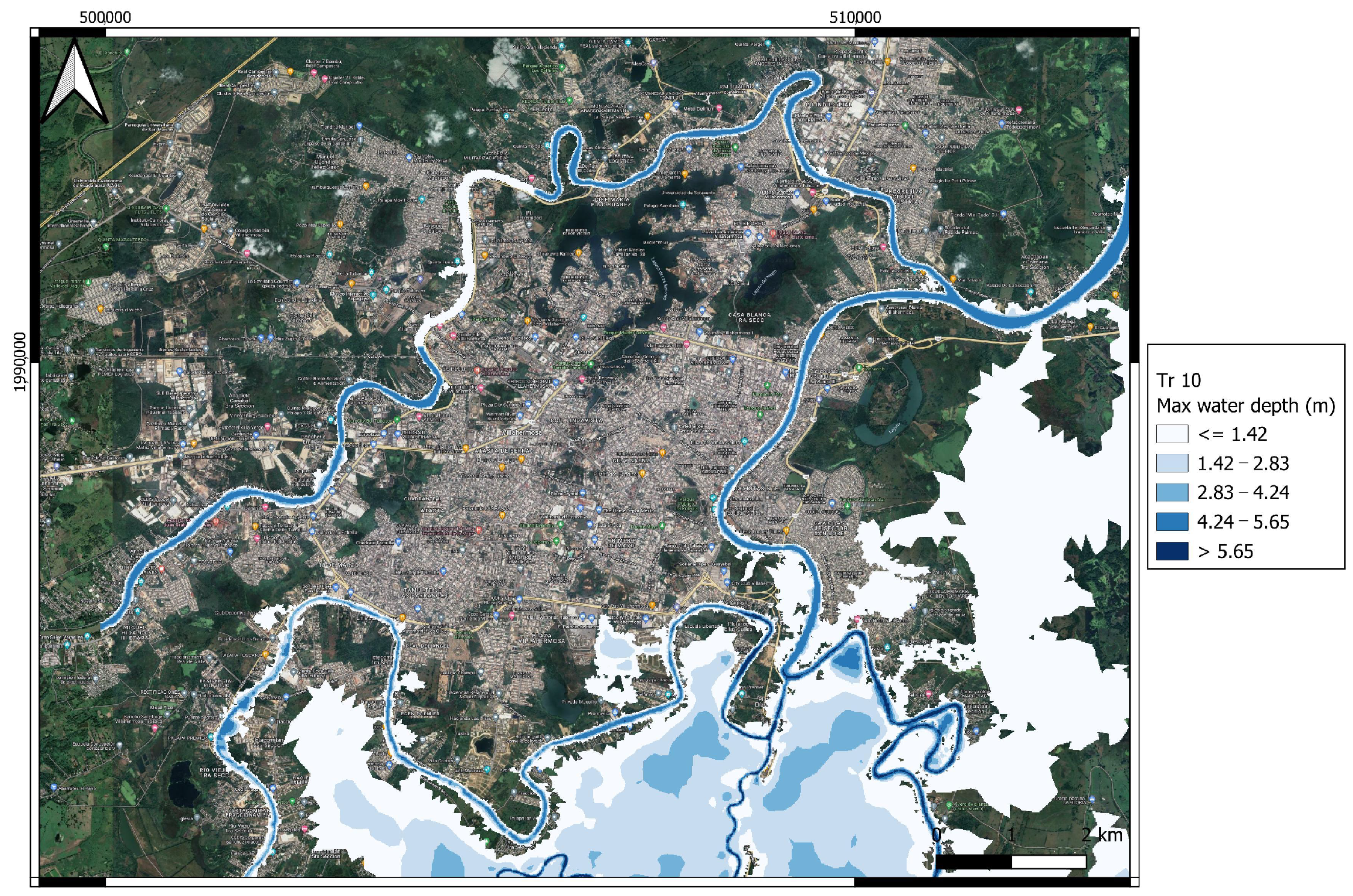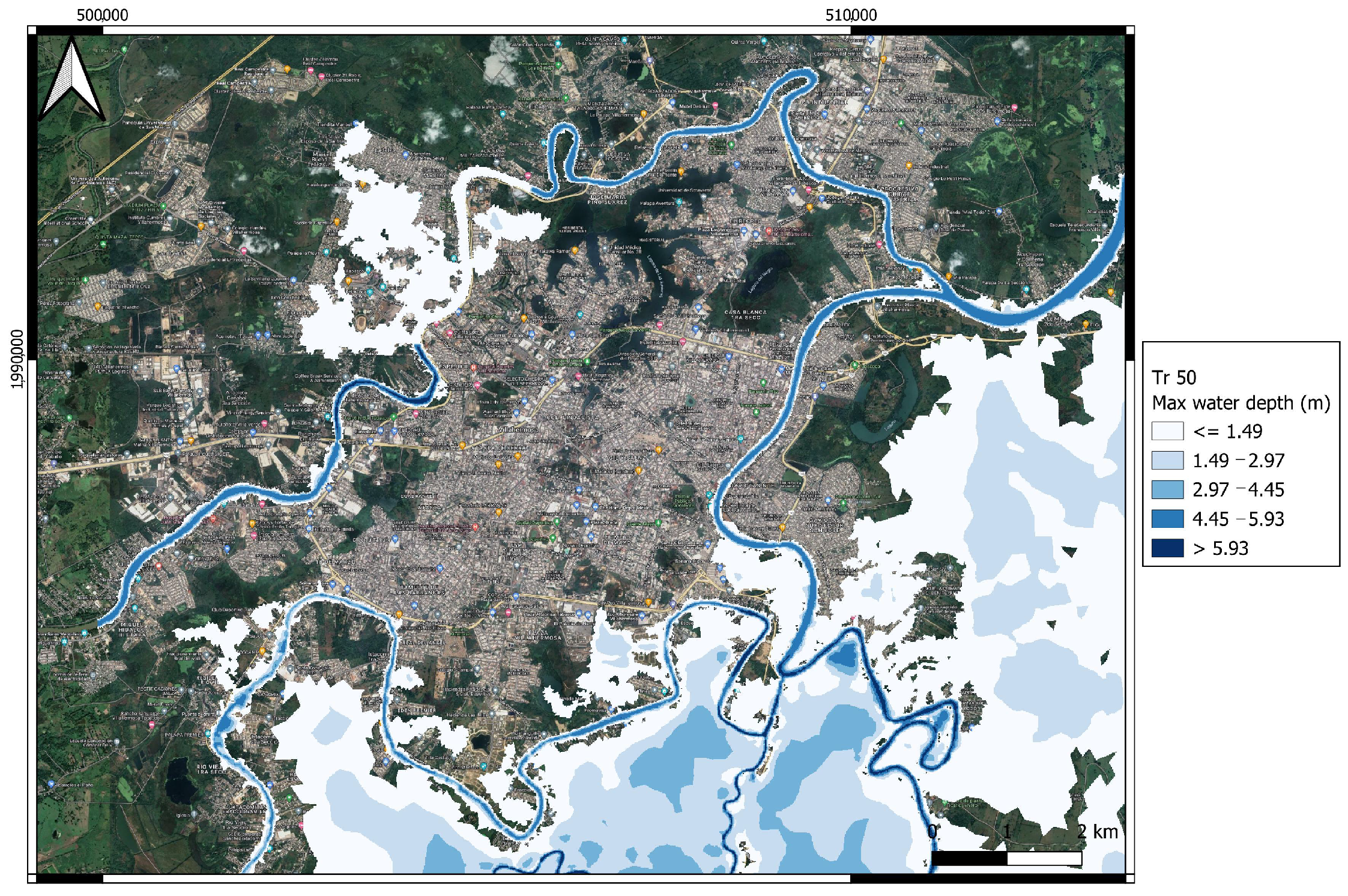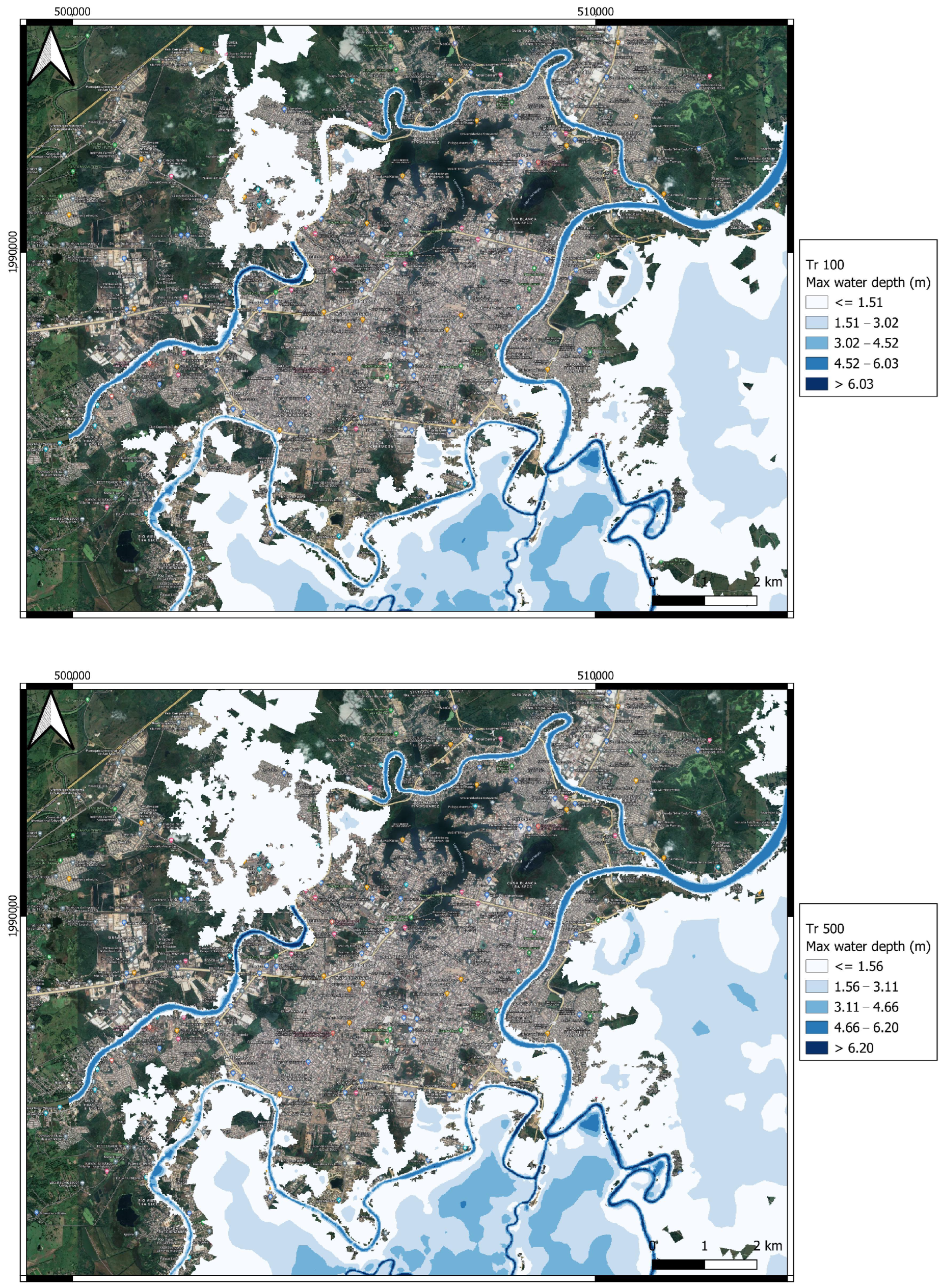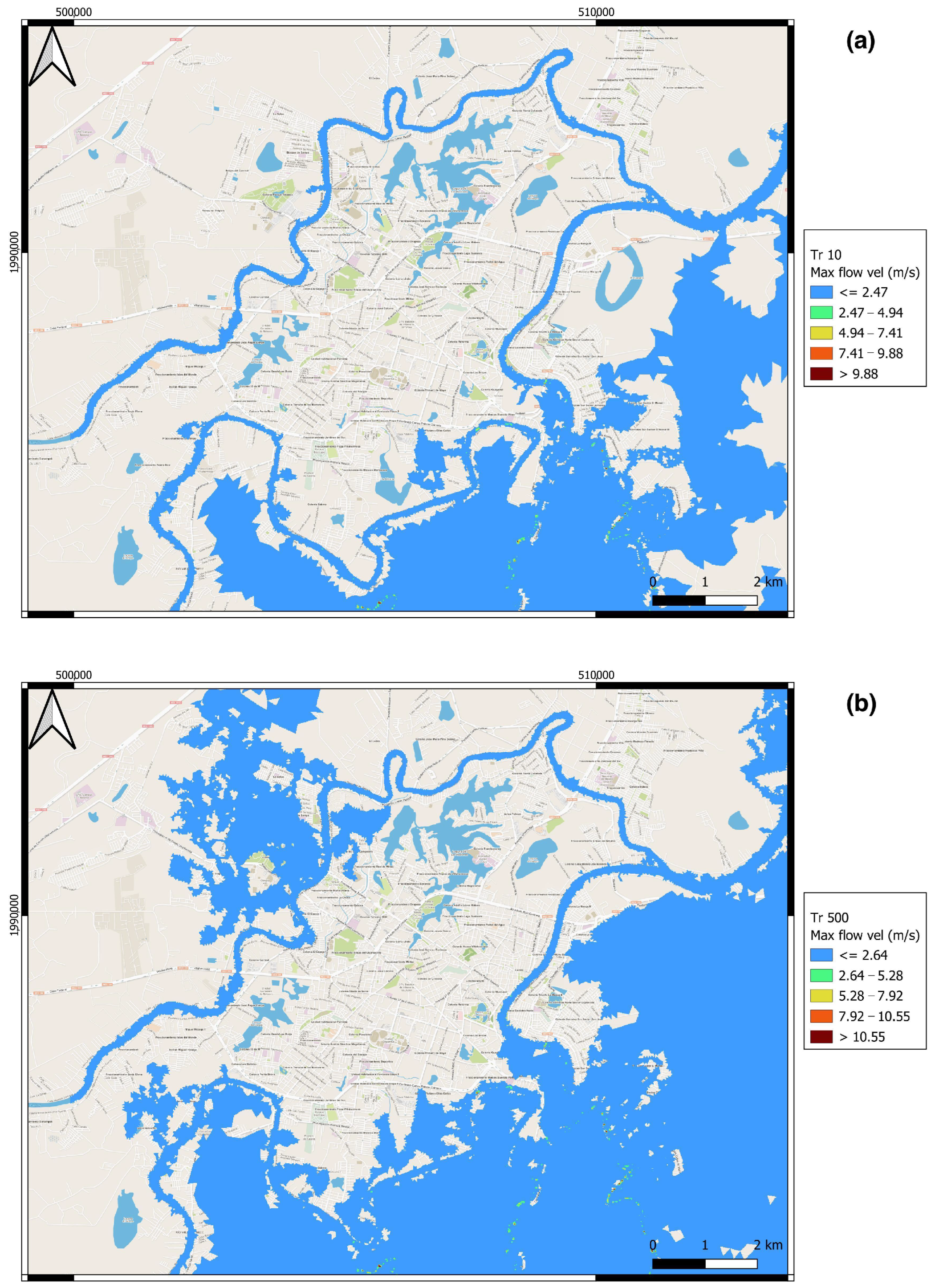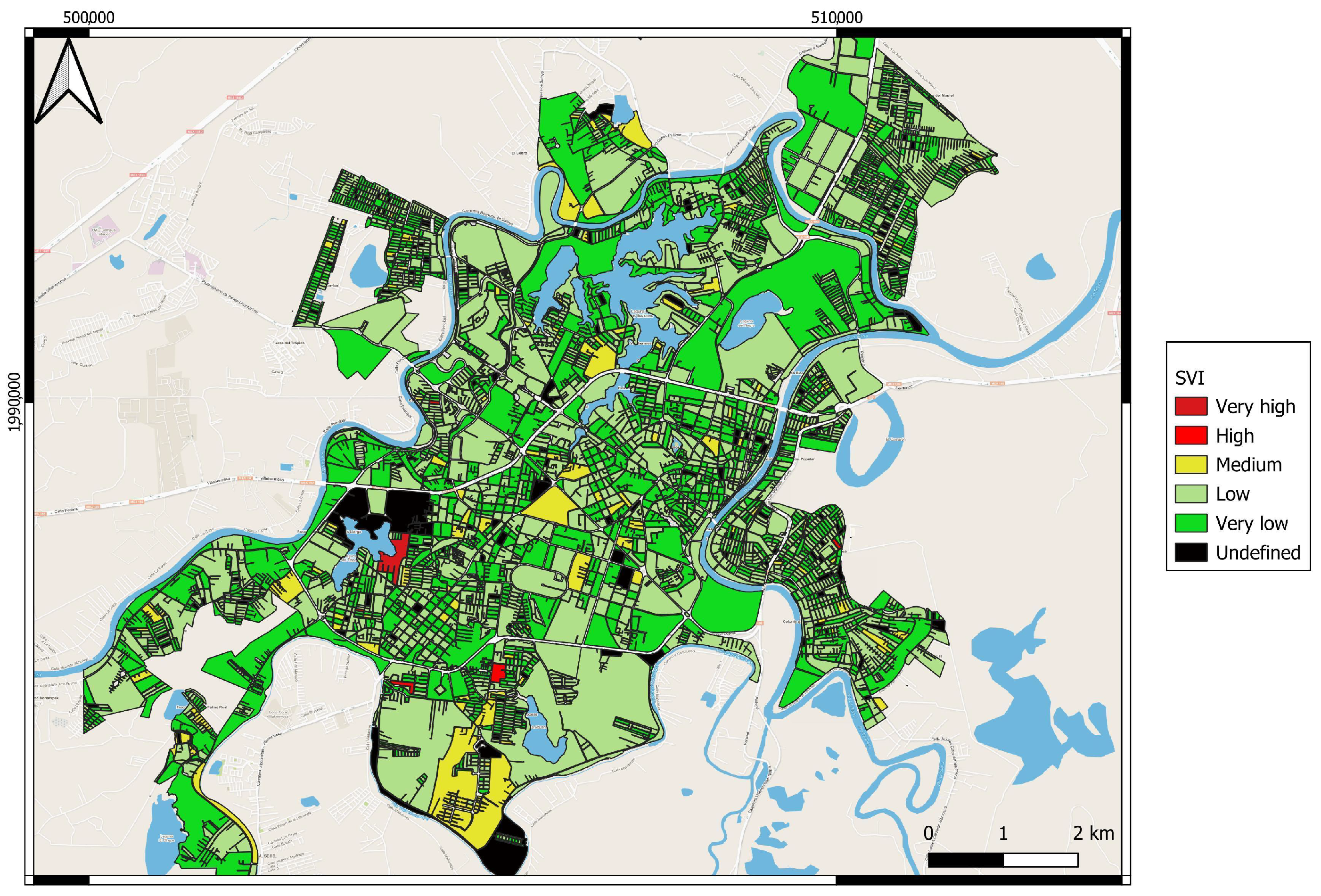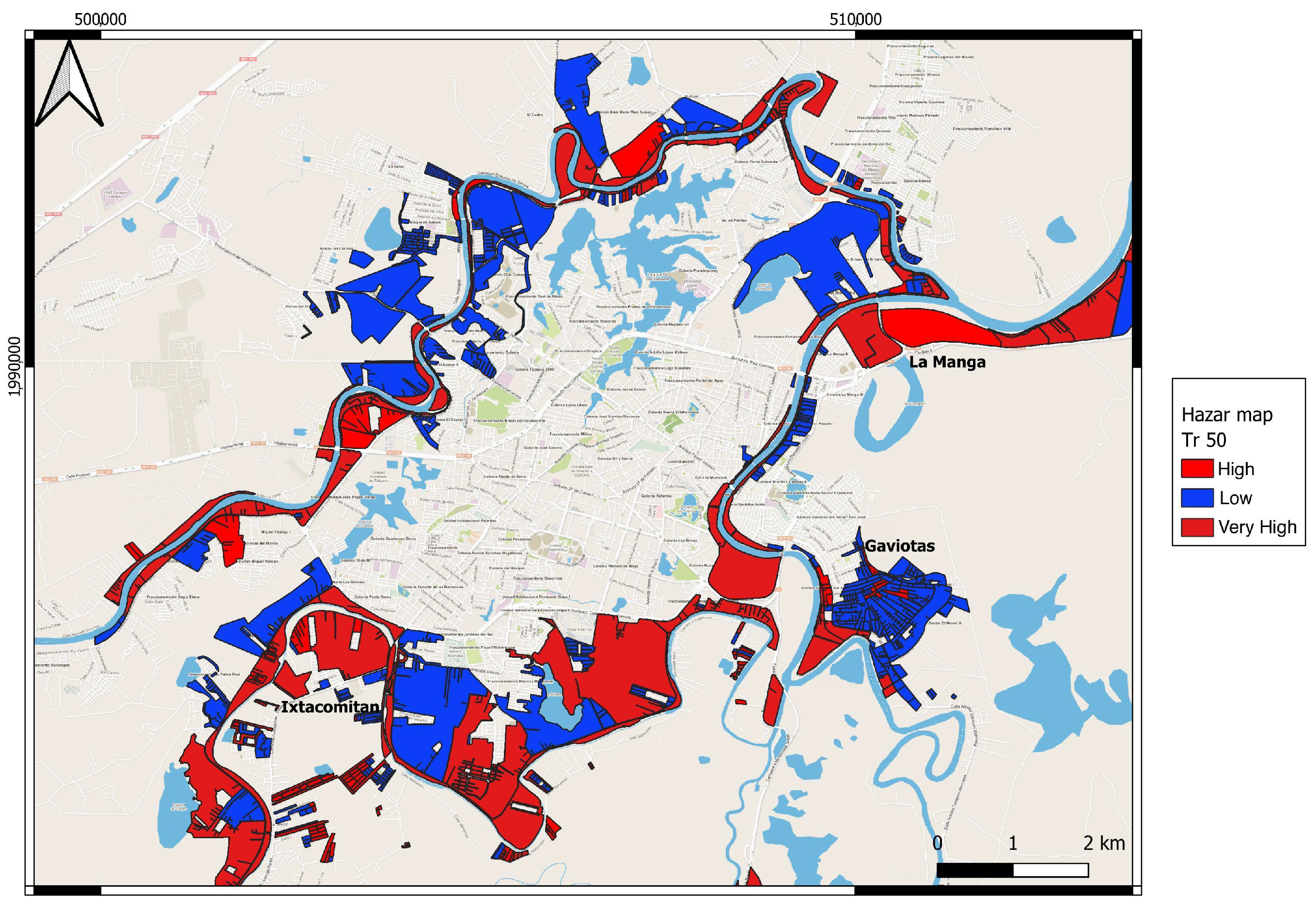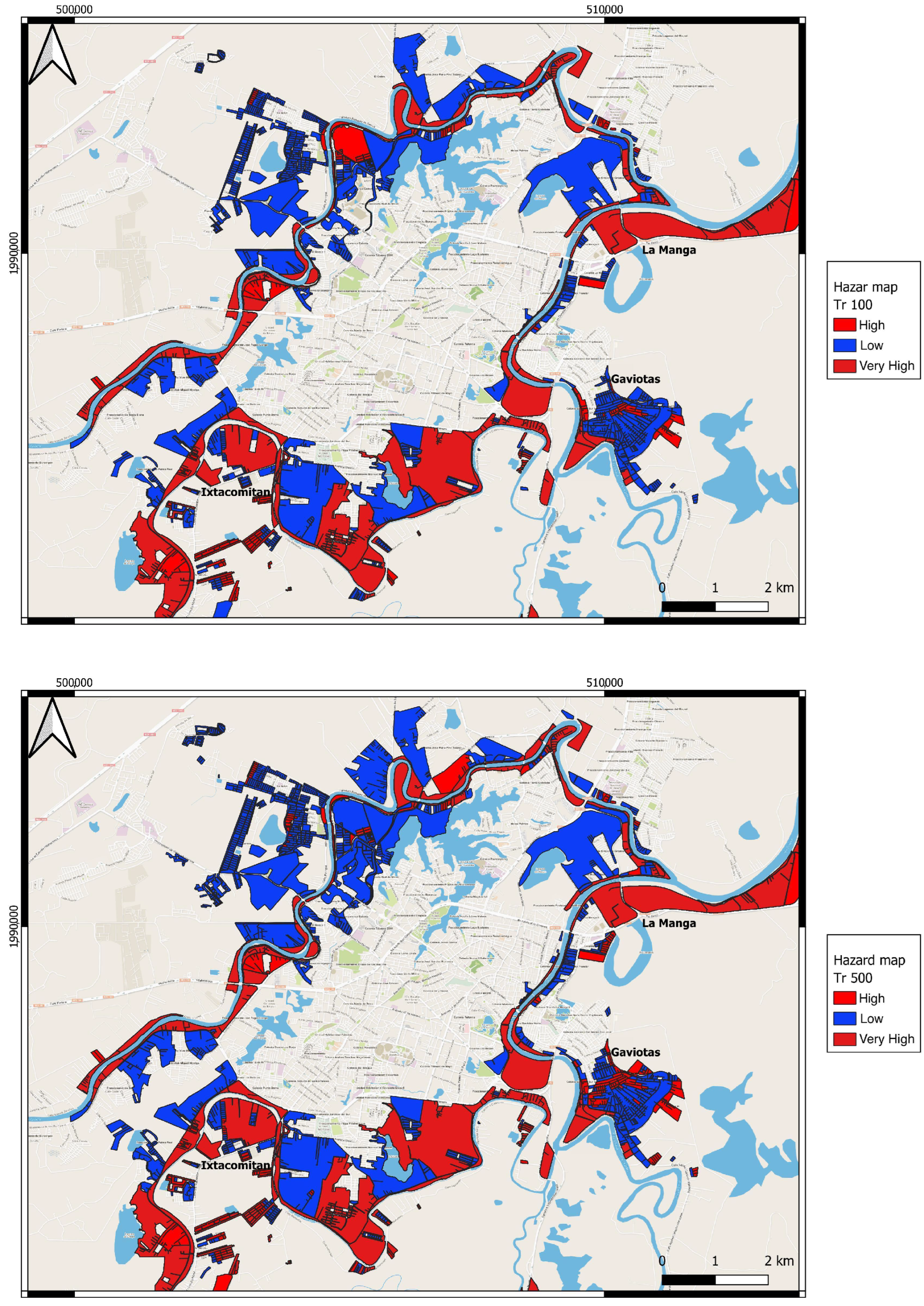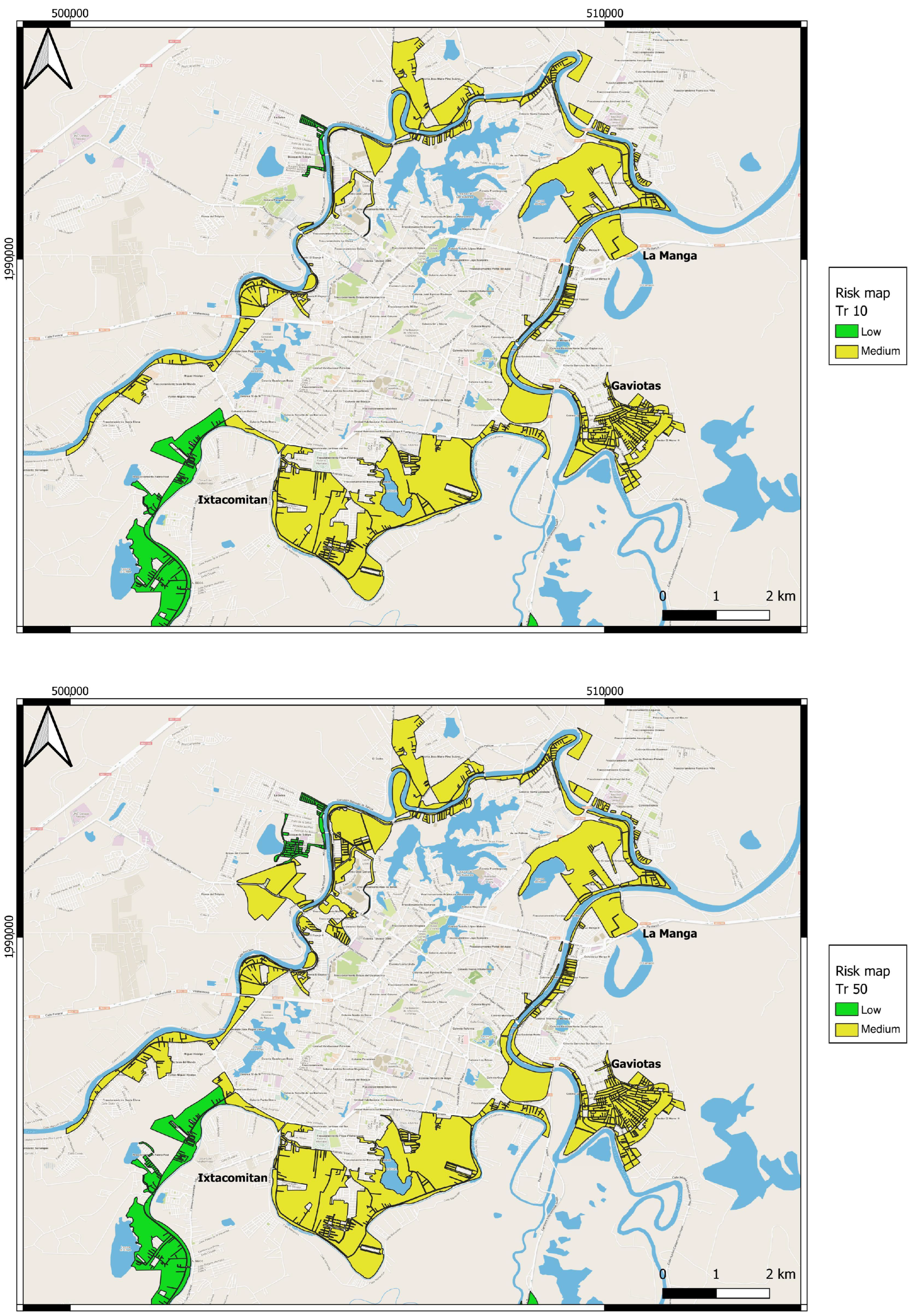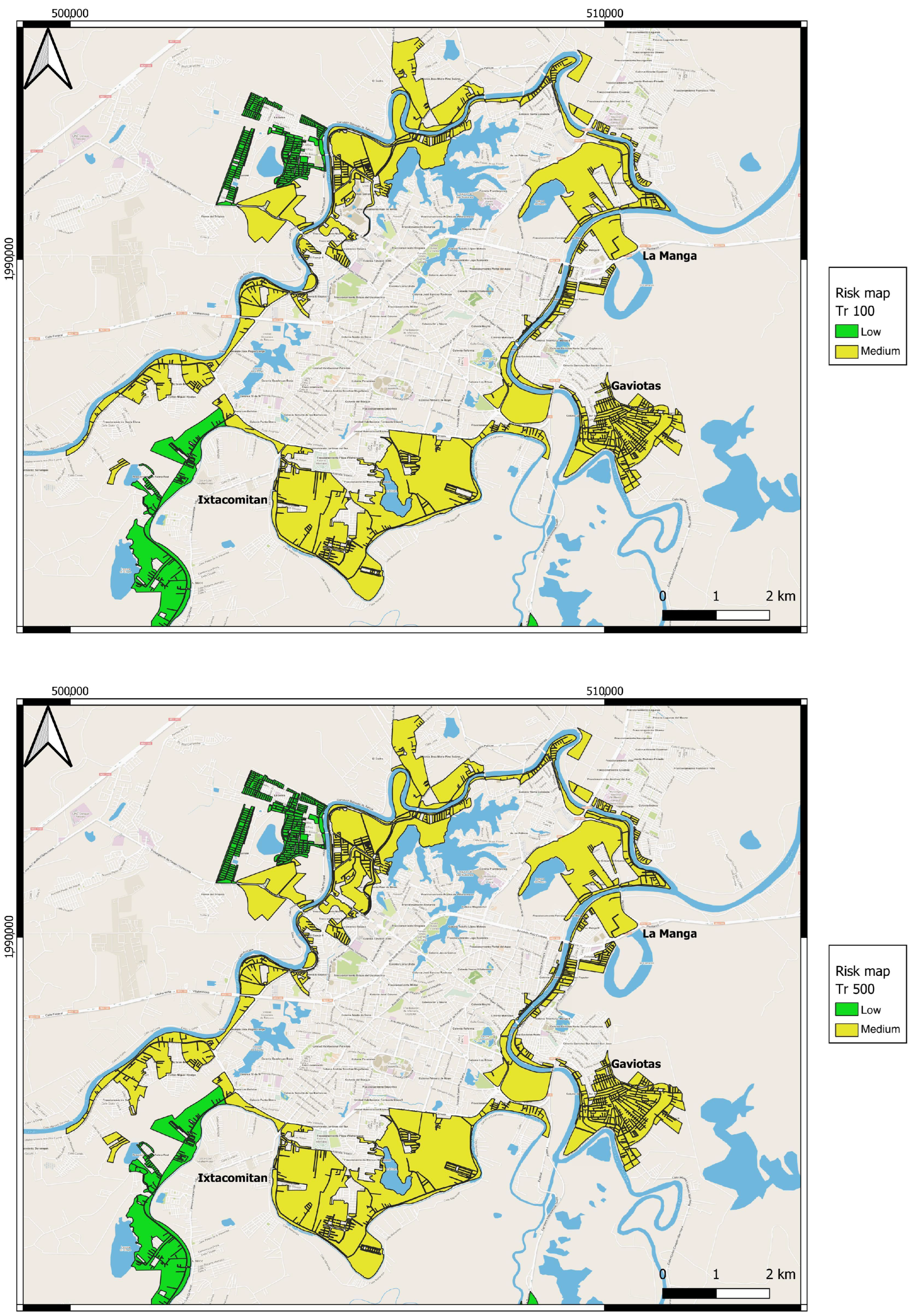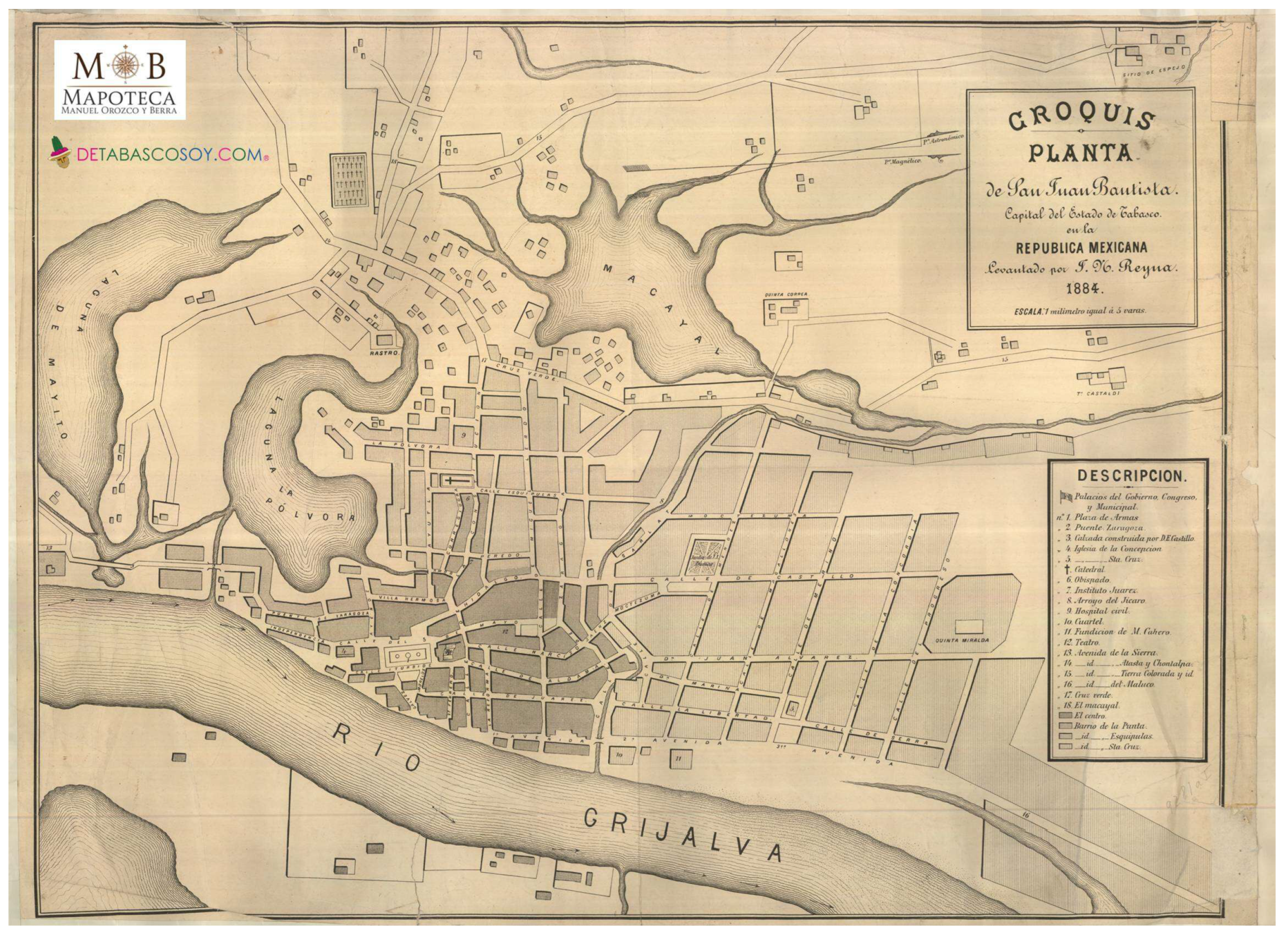1. Introduction
The state of Tabasco has been prone to flooding since historical times. In the 16th century, Spanish chroniclers, Vasco Rodríguez and Melchor Alfaro, wrote in their memoirs about Tabasco: “The land is flooded because of many rivers and because of the continuous winter there is” [
1].
There are many causes responsible for the occurrence of floods in the state and in its capital Villahermosa. First of all, the state is located in the southeast region of Mexico, in a territory where two of the most powerful Mexican rivers converge, the Usumacinta and the Grijalva. Moreover, the region is characterized by the prevailing presence of clayey soil and is located above a semi-confined aquifer that prevents proper water infiltration, due to the propensity to saturation of the sub-surface layer of the soil. Apart from the natural causes that have led to floods since historical times (topography of the area, presence of large river networks, soil type in the alluvial plain), since the 1970s, the basins of these large rivers have experienced a process of intense deforestation which has substantially changed the land use from forest to agriculture, with a consequent radical runoff increase [
2].
Another factor that increments the exposure of these lands to floods is the increase in frequency and intensity of tropical cyclones and other extreme weather phenomena, a fact that, from a climate change perspective, bears global effects [
3,
4]. During the last 20 years, Tabasco has witnessed extreme hydrometeorological events, which have caused losses of several USD million and deterioration of the region’s ecological system. In 1999, the conjunction of tropical waves, a tropical depression and cold fronts, caused the overflow of mountains rivers in the vicinity of Villahermosa. These floods prompted the construction of perimeter walls throughout the city and on the banks of the Carrizal and Grijalva rivers in the following year [
5]. As a consequence of this event, in 2003, the Integral Flood Control Program (PICI) was developed as a proposed solution to the problem of systematic flooding in the capital city [
6]. With this program, three hydraulic systems were planned to protect against the effects of extraordinary rainfall and confine the currents of the Samaria, Carrizal, de la Sierra and Grijalva rivers. However, the project was still in the feasibility study stage when the disastrous flood of 2007 occurred. This year, tropical cyclone Barbara hit the Grijalva river in June and the intense rainfall regime continued until the end of October accumulating 1423 mm of rain [
5]. At the beginning of the weather event, the rain fell continuously for three days. Few people were warned that the dams in Chiapas would be opened, but without an official statement from the government. Twenty-four hours later, the water arrived with a very strong current and flooded 90% of the city in less that 12 h. In some places, it only took 20 min for the water to reach between 2.5 and 3 m depth. The entire city was flooded except for a 10-block radius close to where the cathedral is. People had been desperately trying to stop the downtown area from flooding for at least three days, piling sandbags along the Grijalva and Carrizal all day and all night. Unfortunately, it did not work. Once the water hit, people that were able to make it out of their homes were stuck on their roof tops, those who could not, drowned inside their homes. The level of the Grijalva river was above the ordinary maximum limit from October to November, and floods were also recorded in the Samaria and Usumacinta rivers. This caused the flooding of two-thirds of Villahermosa for almost 40 days. In April 2008, the PICI flood management scheme was reconsidered, for what would be the future Tabasco Comprehensive Water Program (PHIT) [
7]. In 2010, two tropical cyclones led to an accumulated precipitation greater than the one originated in 2007 [
5]. The large dams were pressured with significant water inflows, 12 of the 17 municipalities in the state of Tabasco were declared a disaster area [
8] and all dam and river management protocols were reviewed and updated. In November 2020, a significant rainfall was recorded; flooding, landslides, and water discharge from the Peñitas hydroelectric dam left the region under water. Storms and subsequent flooding inundated 14% of the state, affecting 17 municipalities, damaging nearly 900 communities, with 10,000 evacuees, and flooding thousands of acres of crops across the state. Floods also damaged 2000 km of roads, affected drainage systems and major urban infrastructure, which suffered damages between USD 37 and 93 million [
9].
From the chronicles of these events, it emerges that, for the state of Tabasco, the prevention policy aimed at minimizing the damage caused by floods is ineffective. To carry out a fruitful flood risk management, a long-term assessment of both the probability of occurrence of the phenomenon and its impact is necessary. Risk maps make it possible to obtain a complete view not only of the flood frequency and magnitude, but also of its consequences, providing precise information regarding the damage that a given event can cause. This derives from the risk definition that results from the product of the event occurrence probability (hazard), by the material consequences deriving from it [
10]. The strong spatio-temporal component of risk maps makes them a fundamental tool for prevention policy and correct territorial planning. Moreover, risk maps are pivotal for risk communication, as they provide information that promotes public awareness about the actions that can be taken to minimize damage [
11,
12]. In the last 30 years, several governments around the world have changed the paradigm of traditional strategies for the prevention of flood damage that first was based on mainly structural solutions aimed at protecting flood-prone regions, following the effects of recent events. Many countries, nowadays, have recognized the importance of tackling the problem with a risk-based approach [
13,
14]. From the study by de Moel et al. [
13], it is possible to examine an exhaustive review of the projects and solutions undertaken in Europe to deal with flooding. The United States Federal Emergency Management Agency (FEMA) introduced the National Flood Insurance Program (NFIP) in 2002 [
15] with the objective of acquiring insurance as a safeguard against flood-related losses, in return for adhering to state floodplain management regulations. In Norway, Sweden, Finland, and the United Kingdom, flood hazard maps and risk information serve both as tools for spatial planning and as informative resources for decision-makers [
16]. The perception of risk by populations is a factor that has an enormous influence on the analysis of vulnerability and consequently of the risk itself. In the work of Burningham et al. [
17], it is observed that the incorrect perception of risk in many cases is the result of a risk assessment based on an underestimation of the real impact that a flood can have, hence the urgency of urging populations to participate in awareness and education plans. With the aim of increasing risk awareness, experiments have recently been conducted to demonstrate the potential advantages of virtual and augmented reality as an educational tool in environmental sciences and to provide new tools for communicating important data in planning and decision-making operations [
18].
In Mexico, guidelines for the construction of risk maps and quantitative determination of damage caused by floods were established in 2014 [
19]. These guidelines produced the National Atlas of Flood Risk [
20] that, however, at present, only provides information on flood rates and historical flooding. It is evident, therefore, that an approach based on long-term flood risk forecasting is still absent in decision-making policies, spatial planning and implementation of actions for damage analysis and minimization. The development and use of risk maps would help to foster collaboration between vulnerable communities and local decision makers, implementing what is termed a Participatory Approach [
21,
22]. Furthermore, risk maps encourage the ability to understand, at the community level, one’s own vulnerability, implement shared strategies and activities, to manage flood risk without waiting for the intervention of external entities [
23].
In this work, first risk maps for Villahermosa, one of the most flood-affected cities in Mexico, have been constructed. The methodology applied follows the previously mentioned guidelines of the National Water Commission, to additionally obtain a preliminary estimate of the expected economic damage in the face of different flood scenarios. First of all, a hydrological study was conducted to calculate design flows that intervene on Villahemosa (
Section 2.1). Obtained design hydrographs, corresponding to different return periods, were used as input to the hydraulic simulations of flood scenarios, described in
Section 2.2.
Section 2.3 shows the methodology applied for the construction of vulnerability maps. In this part, social vulnerability indexes are calculated in accordance with the concepts expressed by various authors, according to which economic variables alone are not sufficient to describe the condition of vulnerability of a region [
24,
25]. Here, in the definition of social vulnerability indexes, the factors that influence the interaction between the community and exposure to floods are considered: socio-economic profile, employment, education and housing composition [
26,
27]. Subsequently, hazard maps were constructed based on the severity index calculation, to determine the impact on residential structures (
Section 2.4). Finally, from a Gis-based intersection of hazard maps with the vulnerability map, risk maps were built as described in
Section 2.5. From the results shown in
Section 3, it can be seen that most affected areas are located in the south and southeast of the city, for low return periods, while as the return period increases, northern sectors are also at risk. Although most of the affected areas of the city show a medium risk, the economic damage expected annually from relatively frequent rainfall would exceed USD 14 million.
4. Discussion
Results of this study show that the portions of Villahermosa most impacted by the effects of floods in terms of economic losses are located in the south near the Grijalva and Viejo Mezcalapa rivers, and in the north those located on the banks of the Carrizal river. For frequent precipitation scenarios (return periods of less than 100 years), these areas are already subject to flooding with water levels exceeding 2 m (
Figure 8). These results are validated by local reports which warn the population every year as the rainy season approaches. In fact, the rainy season is almost always accompanied by tropical storms that cause an increase in rainfall intensity every year. For this reason, the Federal Government of the state of Tabasco, together with Civil Protection personnel, meet to define the actions to be taken to help the population in the event of flooding [
50], before the rains begin. These meetings are intended to establish the strategies and government actions to face the forecasts provided by the National Water Commission (CONAGUA), regarding the number and category of tropical cyclones that are expected to occur, both in the Pacific and in the Atlantic Oceans. From hydraulic simulations results obtained in this work, it appears that the increase in the return period results in an increase in flood levels that can exceed 4 m (
Figure 9). Even these results are plausible if they are associated with the extreme weather phenomena, originating from the combination of storms, cold fronts and cyclones, which in the past caused the disastrous floods whose effects are known.
The analysis of the social vulnerability indexes showed that most of the urban districts that conform Villahermosa, have low vulnerability (
Figure 11). This means that the majority of inhabitants living in Villahermosa have access, at least minimal, to medical services (public and private), education is, at least, at the elementary school level, most of the houses have a water supply, and finally, the majority of people are economically active, i.e., there is little economic dependence. These data come from the analysis of the social vulnerability parameters available in the sources cited in the previous paragraphs. The authors of this work are aware that the database used does not include all the social vulnerabilities that influence the study area, and the available data is not complete. Therefore, we consider that the vulnerability of city’s districts susceptible to flooding may be underestimated. The vulnerability of the areas that periodically remain flooded is most likely higher than that calculated in this work. For this reason, future studies dedicated to more precisely e completely identifying the vulnerability indexes of the area are pivotal. Despite this, results of this study show that areas exposed to flooding show a high hazard based on the damage classification corresponding to the hydraulic thresholds of water velocity and depth given in
Table 8. Maps of
Figure 12 and
Figure 13 show that the districts most likely to suffer flood damage are Ixtacomitán, Gaviotas and La Manga. These are the sections of the city that actually suffer the most from the effects of rains, every year. This is due to their position close to the river branches, but also to an inadequate water drainage system to dispose of excess water. During the 2020 flood, the Mezcalapa river flooded the Ixtacomitan section, leaving it underwater for about two weeks, causing major problems concerning lack of food and the onset of diseases caused by mosquitoes [
51]. As a result of the flooding, the Gaviotas section was also underwater for a month. The Gaviotas, located on a southern bank of the Grijalva, has undergone a process of change from a municipal fraction to an urban district in a few years, which has led to the subdivision and sale of lands on the river banks and near water bodies. Furthermore, irregular urban settlements were legally authorized during this urbanization process. While on the one hand, the authorities urged the abandonment of these lands, on the other they offered regularizations, supplies of drinking water and retaining walls for excess water [
52]. The same process was undertaken at the La Manga district which, at the hands of the Secretariat of Agrarian Reform in 1982, underwent the expropriation of 33 hectares of municipal land that were subsequently sold at very low cost, thus favoring the settlement of communities in areas at risk of flood.
From the risk maps shown in
Figure 14 and
Figure 15, it appears that the areas most exposed to flooding are affected by a medium risk index, even for simulated scenarios of high return periods. This classification is sensitive to the construction of the vulnerability indexes and to the variables used for this purpose. As previously commented, the construction of the vulnerability map is affected by the limitations imposed by the lack of complete information to define the socio-economic and demographic variables. For many municipal units in the country, there are little or no relevant data in the national statistical censuses. This could be due to a lack of funds to finance this type of research, to the fact that the country is very large, and the investigations are ongoing but do not yet cover the entire territory. However, this circumstance makes it impossible to find fundamental information such as the existence of civil protection institutions on site, perception of risk by the inhabitants, plans and programs to support the population in the event of flooding. Having this information, the vulnerability values calculated for Villahermosa could be higher. In any case, the calculated damage expected annually, show that more than 33,000 people would be affected by floods for an economic damage of more than MXN 250 million, which correspond to more than USD 14 million.
5. Conclusions
As anticipated and described in the introduction, the Villahermosa problem with respect to flooding has distant roots. Since even before it was constituted into urban districts and before the first dam of the Grijalva Hydroelectric Complex came into operation in 1964, the territory was periodically flooded causing damage to crops and farm houses. The original layout of the city of Villahermosa shows that the Grijalva river was wider than can be seen now (
Figure 16).
The dock was located close to the original and main market of the city, and people who wanted to sell and buy their products would arrive via long, shallow boats [
53]. Currently, this area is now three-to-four blocks away from the riverbank, however still within the downtown area of the city which encompasses the current dock of the Grijalva, and the area known as the Malecon. The reduction in width of the river that led to the current distance of the market from the river was caused by the draining of the Macayal and the La Polvora lagoons and the land used for construction. In recent years, the impact of floods has increased due to the construction of dams, their malfunctions, and poor urban planning. Hydraulic simulations in this study reveal that the most severely affected areas in the city experience prolonged and deep flooding, and these areas tend to be inhabited by marginalized communities, heightening their vulnerability and risk. Relocating to safer districts is not feasible for these populations without external financial assistance. Moreover, there is uncertainty about the risk perception of residents in these flood-prone zones. Historically, the people of Villahermosa were more aware of the risks and adapted their homes accordingly, but this perception has evolved. Today, various factors, such as cost and trends, lead people to live in flood-prone areas.
Risk maps, like those presented in this study, can certainly act as a tool to educate and create awareness about flooding and its consequences [
11]. In Europe, as a result of severe floods that occurred in the 1990s, information systems were developed through the use of risk maps that describe the hazard and impact of floods, fundamental elements for populations at risk to be able to protect themselves and coexist responsibly with the environment [
54]. Creating risk maps for Villahermosa, given the current available data, is a challenging undertaking. However, this study serves as an initial step to stimulate further research focused on developing comprehensive databases for constructing precise risk maps in Villahermosa and other flood-prone areas in Mexico. The goal is to lay the groundwork for promoting greater public awareness and informed territorial policies regarding flood risks. In Mexico, there is a lack of a dedicated disaster prevention policy for natural events [
22]. This deficiency is possibly due to the National Civil Protection System’s relatively recent establishment following the 1985 earthquake in Mexico City. Moreover, the decision-making process during disasters is decentralized, and local administrations have limited capabilities for hazard assessment and civil protection. To address these issues, the creation and implementation of national-level risk maps are crucial for flood disaster prevention in the country.
The methodology in this study forms a strong foundation for flood risk management, community safety, and sustainable development. It presents a vital tool for the scientific community in addressing hydrological hazards. Moreover, it enables precise identification of flood-prone areas, facilitating flood event prediction and mitigation planning. Additionally, it aids in estimating the financial impact of floods, empowering the scientific community to develop loss-reduction strategies. Furthermore, it supports the evaluation of current public policies and the creation of more effective ones.
